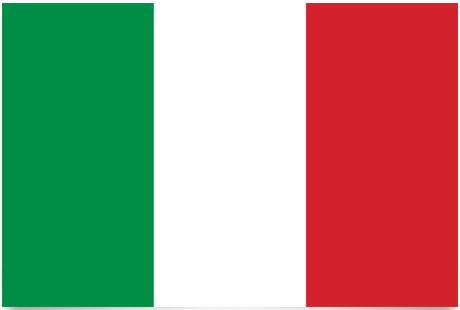Italy Flag and Meaning
Flag of Italy

Italy Flag Meaning
The Italian flag has three vertical ribbons in green, white and red that are equally wide. The flag originally comes from the flags that Napoleon introduced in northern Italy in several smaller states of obedience in 1797. The Italian flag has a design inspired by the French tricolor. In 1861, Italy was united and then the design and colors of the flag were retained. A small change was then made to the flag by introducing the coat of arms of the royal house of Savoy in the middle white field. Then Italy became a republic in 1946 and the weapon was removed from the flag. The flag was officially adopted on June 18 of that year.
It is not known for sure where the Italian flag got its colors. It is believed that the colors come from the civic militia in Milan. The uniforms the militias wore were in red and white and white with a few details in red.
Italy Overview
| Population | 57.5 million |
| Currency | Euro |
| Area | 301.270 km² |
| Capital city | Rome |
| Population density | 190.8 residents/km² |
| HDI location | 23 |
The northern part of the country consists of the lowlands around the river Po and is bounded in the north by the Alps. It is the center of the country’s economic activity and has the largest industrial and agricultural production. In the peninsula divided by the Appennines, agricultural production is dominant – especially the production of olives and grapes. Italy also consists of the islands of Sicily and Sardinia.
The people: Italians 94%, sarer 3%, others 3%.
Religion: Predominantly Catholic
Language: Italian. Linguistic minorities: German (about 330,000), Albanian (about 150,000), Slovenian (about 100,000) Ladinese (about 730,000), Catalan (about 15,000). Italian linguistic minorities are Sardinian, and other regional languages.
Political parties: The former right-wing coalition of government consisted of the “Freedom People” led by Silvio Berlusconi; the separate movement Lega Nord under the leadership of Umberto Bossi; Christian Democratic Center; Christian Democratic Unity and the New Italian Socialist Party.
Social organizations: Italy’s workers are affiliated with 3 different National Organizations: CGIL affiliated with PDS, CISL affiliated with the Christian Democrats and the Social Democratic UIL which mainly consists of socialists and others. The three main organizations today represent a small proportion of Italy’s employees, and the same must be said for employers’ organizations in relation to employers. Smaller labor organizations (the autonomous ones) flourish, and most employers (small and medium-sized enterprises) have completely stopped being affiliated with any trade union organization.
Official name: Repubblica Italiana
Administrative division: 20 regions divided into 95 provinces and 8102 municipalities.
Capital: Roma (Rome), 2,744,000 (2009)
Other important cities: Milan, 4,047,500; Naples, 3,620,300 residents; Palermo 947,300 residents; Turin, 1,619,400 residents (2000)
Government: Acting President of the Republic is Sergio Mattarella since February 2015. Government: Giuseppe Conte has been Prime Minister since June 2018. There are 2 chambers in Congress: the 630-member Chamber of Deputies and the 315 Senate.
National Day: June 2 (Republic Day, 1946)
Armed Forces: 216,800 (2001). It has been decided that the military service will be gradually phased out until 2006. The Italian army will then only be professional, with access for both women and men.
Paramilitary forces: 111,800 carabinieri ; 80,400 members of the Public Security Guard; 64,100 members of the tax police.













































